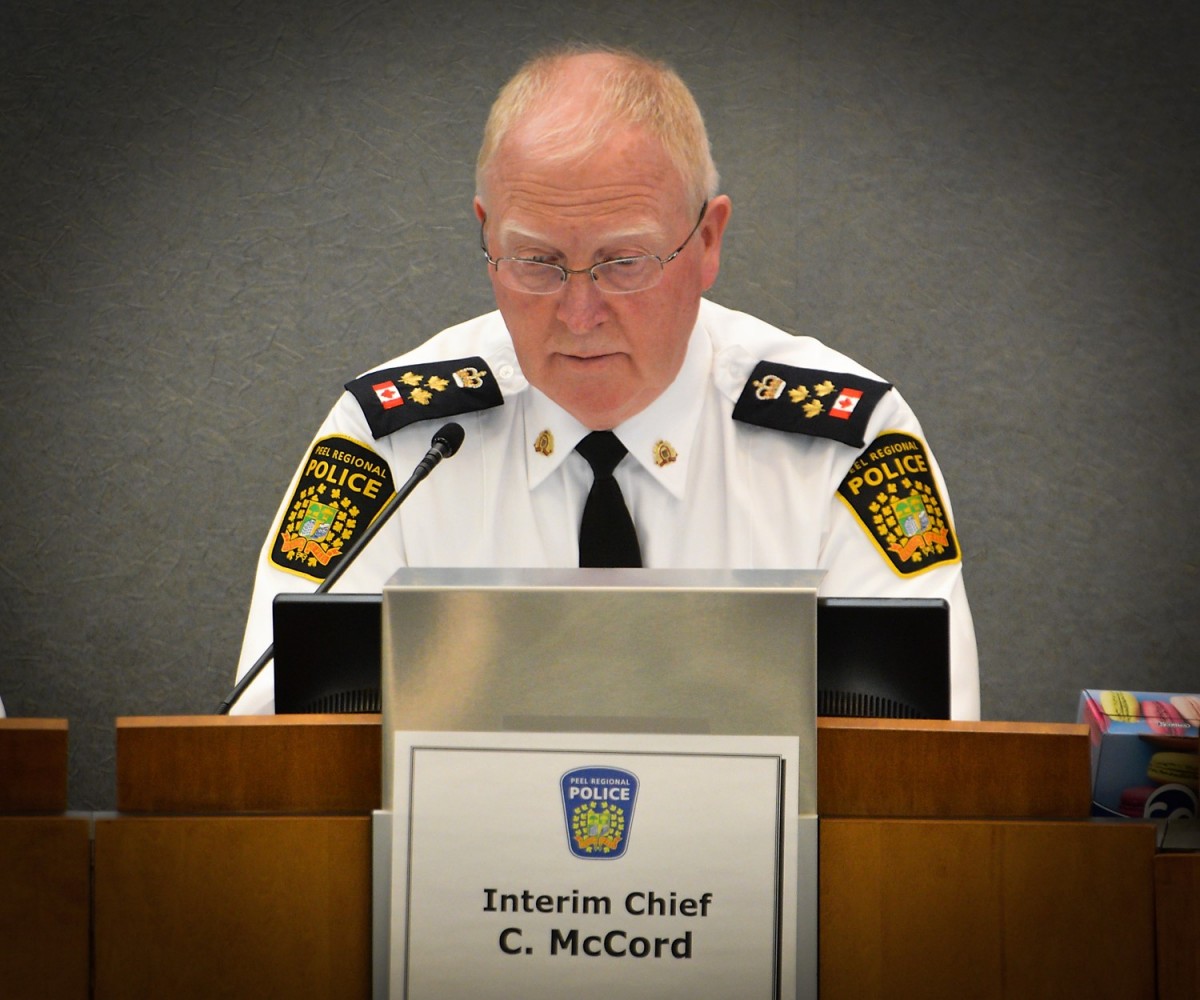
Scathing equity report finds widespread harassment and discrimination within Peel police, blames leadership for a culture that fails to reflect region’s diversity
A diversity audit of the Peel Regional Police has dismantled any doubt about the service’s failure to live up to its own statements about diversity and inclusion, painting a picture of a police organization that systemically discriminates, harasses and punishes those who come forward with serious concerns.
After months of delays, a diversity audit completed by the Canadian Centre for Diversity and Inclusion was presented to the Peel Regional Police Services Board earlier today. It reinforced many of the complaints and concerns that have been raised by community advocates for years.
Brampton Mayor Patrick Brown told the board he was “grateful” to see signs that action is being taken to address the issues.
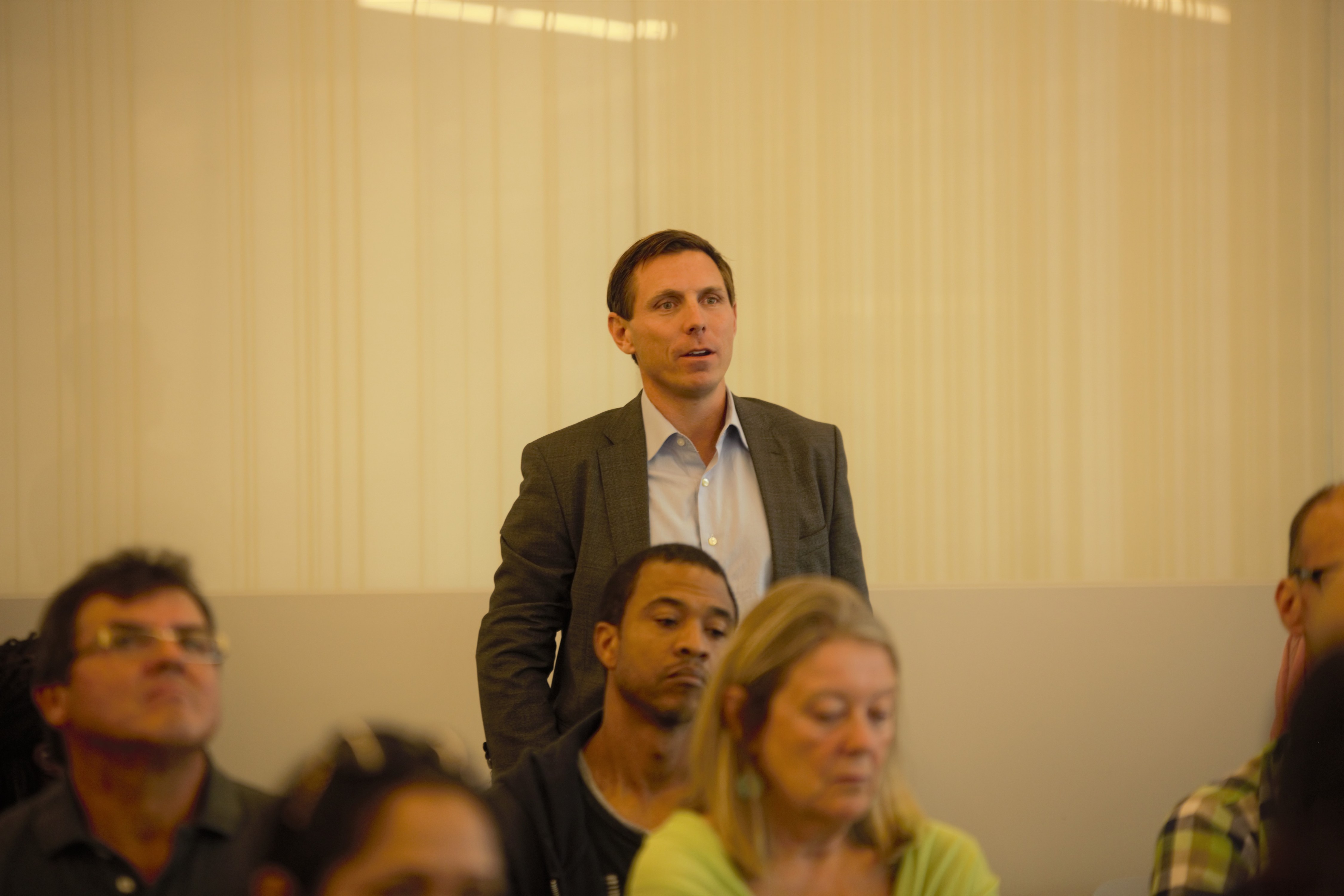
Mayor Patrick Brown, at a community meeting on crime in the summer, says the audit report is long overdue.
“The fact that we’re finally taking action I believe is long overdue and I think will be appreciated in the community,” he said. “We all know we have to do better on diversity and inclusion, and hopefully this report is the spark for that to happen.”
Mississauga Mayor Bonnie Crombie, a progressive voice on the board in the past, who pushed for the audit in 2016, said she was pleased with the report and said it provides a path forward to rectify systemic racism in the Peel police service.
“I truly feel that systemic racism occurs everywhere. In my organization, in Peel police, in every corporation; to be aware of it and how it occurs is the best way to defend yourself and address it and overcome the systematic bias and racism that exists,” she said.
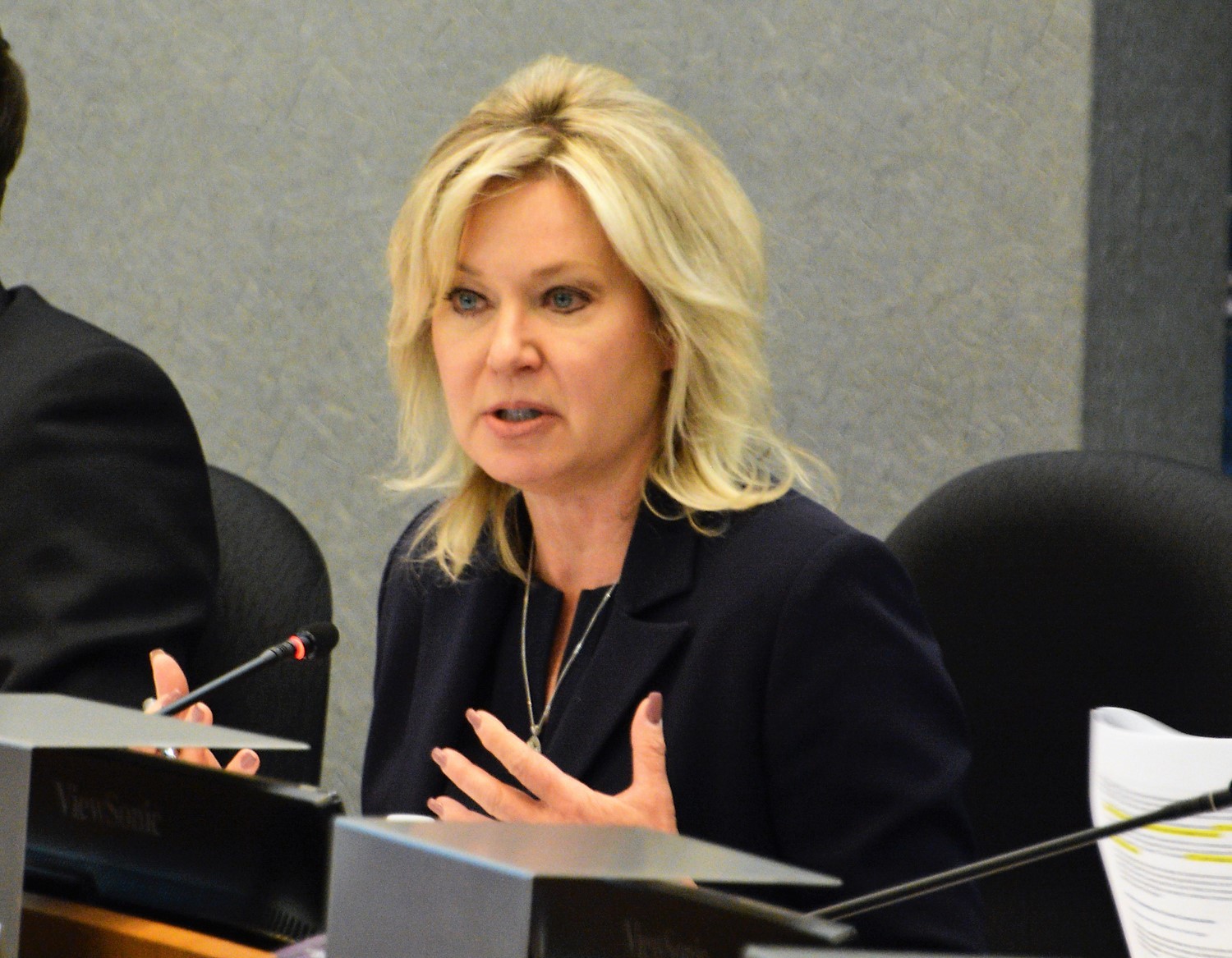
Mississauga Mayor Bonnie Crombie at Friday's police board meeting.
The 142-page document describes a police force that doesn’t represent the fast-changing, diverse community it serves, raises barriers for racialized members of the force, punishes those who speak out, and has turned a blind eye to systemic bias. According to 2017 data from the force, 20 percent of uniform staff were racialized (425, out of a total uniform complement of 2080), while PRP’s jurisdiction, Brampton and Mississauga, is 65 percent visible minority and aboriginal. Non-uniform staff are slightly more representative of the community.
The review by CCDI included one-on-one interviews with PRP senior leadership, two public town halls, a census and inclusion survey of employees (garnering 1,808 responses out of 3,048 workers, including civilian staff), and focus groups.
A disturbing 79 percent of Peel police employees who took part voluntarily in focus groups reported experiencing harassment or discrimination within PRP, while 90 percent of participants reported witnessing such behaviour.
Despite the force's recent contention that it has begun to address systemic problems, the CCDI report states, "there are significant challenges related to the rigidly hierarchical paramilitary organizational culture of policing in general, as well as identified aspects of the Peel Regional Police in particular… . Some of the fundamental issues cannot be solved by more programs and initiatives, or changes to policies and directives. This suggests a need for more extensive culture change. We recommend that PRP create a task force or working group involving members of the Chief’s management group and others throughout different ranks and divisions within the organization to identify the culture PRP wants to create in the future, what aspects of the organizational culture need to change and/or can reasonably be changed, and use a rigorous change management approach to embark on an organizational culture change initiative."
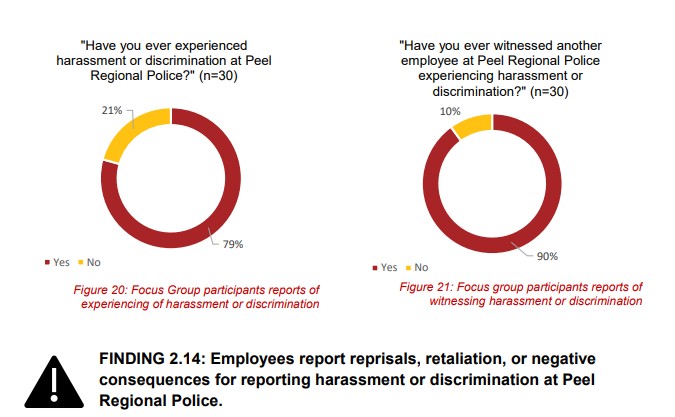
The CCDI report places most of the blame for these issues on senior leadership with the PRP, with a majority of employees describing the organization as “change-averse” and “elitist.” The report says almost three-quarters of police leaders and members of the board “do not seem to recognize that barriers exist or [believe they] rarely exist for certain groups at Peel Regional Police.”
About a third of the PRP leaders in place in 2017-18 “indicated their belief that these systemic oppressions do not exist within PRP,” while others suggested they believe “these oppressions manifest only as individual acts of meanness.” These leaders, the report says, don’t make “the connection that these oppressions are systemic in our society and therefore are also in our organizations.”
However, when rank-and-file employees were asked if “everyone benefits from equal access to resources and opportunities” within the PRP, only half of the more than 1,800 who filled out a survey offered a positive answer. According to Michael Bach, the founder and CEO of the CCDI, an industry benchmark for such a question is 70 percent.
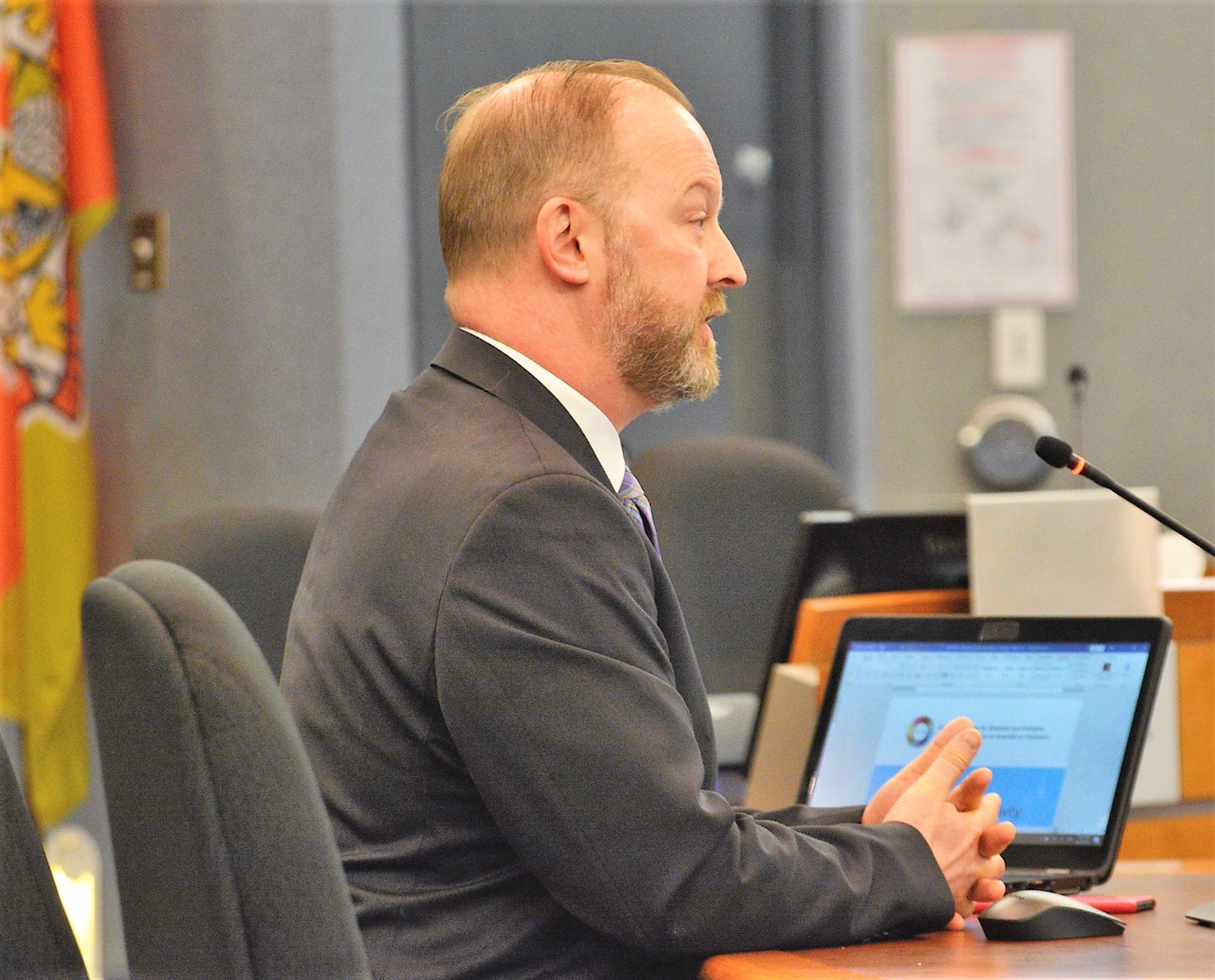
CCDI CEO Michael Bach
He told the board that there is an apparent “divide” between the understanding of police leadership and the lived experience of employees.
According to the report, 93 percent of police leaders believe the force is committed to diversity and inclusion and that it exhibits fairness, consistency and flexibility.
“In contrast, only 41 percent of focus group respondents had a positive response to this question,” the report says, with straight, white, able-bodied men being the most likely to agree. “None of the Racialized or Newcomer respondents responded positively.”
Many anonymous employee comments included in the report highlight that view, like this one: “Peel Regional Police on the outside makes it look like we are an inclusive place and value diversity. From my experiences, senior management believe quite the opposite. They pose for pictures, say all the right things but then behind closed doors, actions are very different.”
This disconnect between the opinions of employees and senior leadership is one of the issues highlighted by CCDI.
“Our analysis suggests that the biggest obstacle to the Peel Regional Police addressing issues of diversity, equity and inclusion in the police service may be the mindset of leaders and service members, demonstrated by a lack of acknowledgement that there are real systemic problems to address.”
The Ontario legislation that serves as the guideline for policing in the province, the Police Services Act, explicitly states that forces must reflect the community they serve.
Interim police chief Chris McCord said the report will provide “great value” to the PRP and acknowledged to the board that it “clearly says we need to continue to grow as a police service.”
“Our aim is to use the findings in this report to make us a best in class policy agency,” he said. “We recognize there is a lot of work ahead of us. We will support our leaders and employees by enhancing their cultural competencies.”
“I assure you, we have heard you, there is room for improvement, and Peel Regional Police will be better because of your input,” he added.
Ranjit Khatkur, the co-founder of P-CARD (Peel Coalition Against Racialized Discrimination) was instrumental in bringing the audit about, after she and other groups delegated the police board in 2016, demanding a sweeping review of equity practices.
“Much of what is in this important report was known to members in the community and many in the criminal justice system,” she said after attending Friday’s meeting.
“Evidence in the BJ Sandhu case [the officer who won a human rights case against the force in 2017 after being discriminated against] clearly showed the widespread effects of failed leadership in the force, and the fears of reprisals since his case against at least one of the witnesses [Inspector Raj Biring, who faced an unusual internal Police Services Act charge brought forward by former chief Jennifer Evans shortly after he testified in the Sandhu case], are supported by the audit’s findings, which show many officers are fearful of addressing the rampant harassment our organization has been told about by officers for years.”
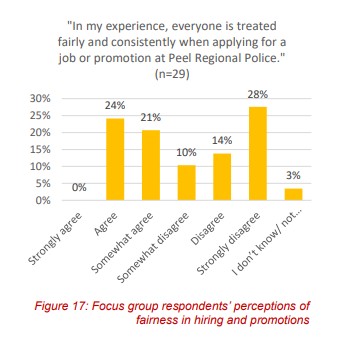
In 2017 the Ontario Human Rights Tribunal ruled that Peel police had discriminated against the highly decorated South Asian-Canadian officer, who in 2013 had sought promotion into the senior ranks but was prevented from entering the competition for promotion to inspector. After months of hearings, the tribunal found Peel police “generally” devalued police work in the huge South Asian community because it is “associated with the South Asian population.”
Officers who testified in the hearings recalled a frat-house culture in which racist cartoons and emails were spread among officers, along with racist jokes and racially demeaning names such as “Gunga Din”. Leaders not only ignored but often took part in the racist behavior, including one manager who posted an overtly racist cartoon on the office wall.
The tribunal ruled that Sandhu’s failure to get a chance at promotion was, in part, due to his ethnicity. “And as such I find that the applicant has been subject to discrimination because of race, ancestry, place of origin, and ethnic origin in violation of … the [Human Rights] Code,” wrote Bruce Best, a vice-chair of the tribunal.
The force tried to prevent the application packages of candidates from being used in the hearings, but the tribunal ordered the force to produce them and the evidence showed that many of the more than 30 candidates allowed to compete for the inspector’s position had far poorer qualifications than Sandhu, though his supposed lack of experience had been used as justification for excluding him from the promotional process.
The audit report released Friday indicates that 52 percent of officers in the force believe favouritism, not merit, determines who gets promoted and who doesn’t.
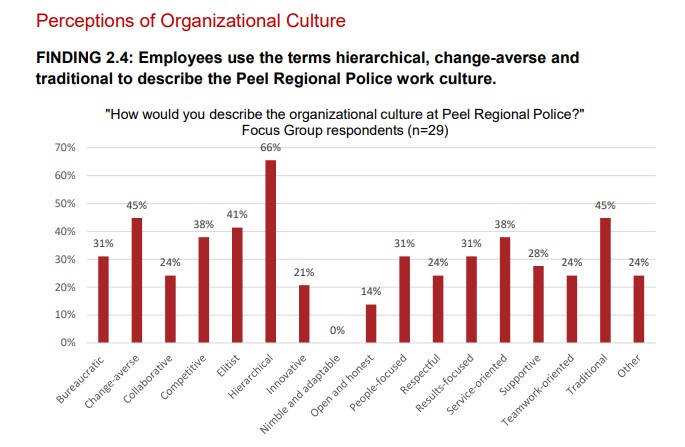
Then-chief Jennifer Evans released a video statement immediately after the tribunal ruling, assuring the public that promotional practices had changed since 2013 and the circumstances of Sandhu’s case were “not reflective of the force’s values.” She offered no apology, and the force has yet to offer any public acknowledgement or apology to him or the South Asian community.
The report itself makes reference to the Sandhu case, remarking that “This continued belief by some leaders and board members that there is no racism is disconcerting when we consider the Interim Decision in 2017 by the Ontario Human Rights Tribunal.”
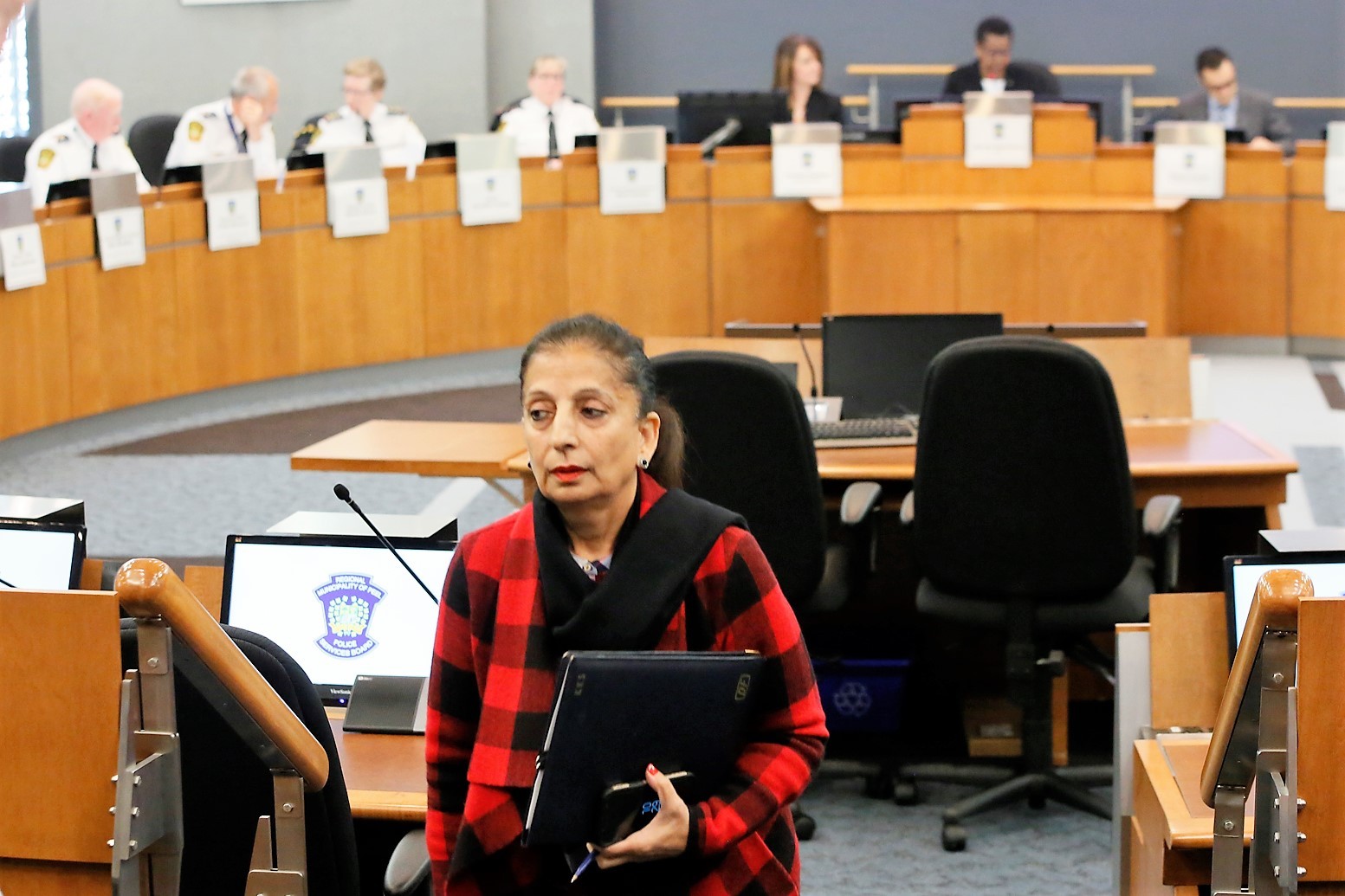
P-CARD co-founder Ranjit Khatkur
Khatkur says the report should point the way to one clear outcome.
“It makes it very obvious that leadership has failed; they won’t acknowledge the problem, they point to so-called efforts being made, they don’t even understand the dynamics of these really serious problems, ones that affect public safety. So, when the board decides on a new leader, unless it wants more of the same, we have to bring in the right candidate from outside the force who can bring a fresh, unbiased, professional and modern approach.”
Speaking after the meeting, McCord said the report highlighted many areas for improvement. The rapid pace of growth in Peel Region has been a challenge for the PRP, he says.
“What you have to remember is we are very unique as a community. We have grown so rapidly and the diversity in this community has grown so rapidly, and we have challenges to try and keep up to that, and we are trying to catch up and keep up to it,” he says.
But McCord didn’t acknowledge more alarming shortcomings highlighted in the report, where the findings point to a clear cultural disconnect.
To assist in boosting diversity in the PRP, the organization is creating a new position. This person will report directly to the chief and ensure “cultural competency and a diversity and inclusion lens is applied to all aspects of Peel Regional Police, both internally and externally,” according to a release from the Police Services Board.
Improving the PRP leadership’s “cultural competency” is a key aspect of eliminating the divide between what senior leaders believe about their organization and what employees are experiencing. “That’s only going to be done through education,” McCord said.
Police board chair Nando Iannicca said he was pleased the report was accepted unanimously and also accepted by senior police officials.
“In its own way it’s our own reconciliation report saying, here [is] the state of affairs, we’ve acknowledged it, we’ve accepted it, here’s the road map going forward,” he said. “It wasn’t sugar-coated or whitewashed; it was a true [reflection] of the state of affairs and, really, if you can’t measure it you’re not going to manage it properly.”
Iannicca described the report as “sobering,” and acknowledged it verified things community advocates have been saying for years.
“We must hold ourselves to the highest possible standard. We can always do better,” he said.
But he stopped short of an apology, noting that while the review has been underway, there has been turnover in both the chief and chair positions, and it’s time to move forward.
“I think the report does confirm some of the concerns the broader community may have had and I think that affirmation is very important to them,” he said. “I don’t know that we want to look in the rearview mirror. This is all about accepting the report and moving forward and having everybody buying in to do better.”
That may be difficult to do in light of recent history.
Jennifer Evans’ predecessor, Mike Metcalf, in 2007 refused to acknowledge the need for cultural sensitivity training ordered by the Human Rights Commission after a ruling against the force in a racial profiling case. Metcalf publicly stated he did not agree with the finding, despite damning evidence.
Evans lashed out against the board when it called for the audit, following pressure from community groups, and its results were supposed to be presented last year, while Evans was still chief, but they were kept under wraps. After she suddenly announced her resignation in the fall, then departed in January, the board stated the audit results would be released.
The most contentious issue dogging the PRP on race has been Evans’ steadfast support of the “street check” process, colloquially known as carding. In Peel, where 9 percent of the population was Black, the force’s data over a five-year period showed that on average almost 25 percent of those being stopped on the street and asked for ID without a legitimate crime-investigation reason were African-Canadians. Between 2009 and 2014, Peel police conducted 159,303 carding checks, with black people three times more likely than white people to be stopped.
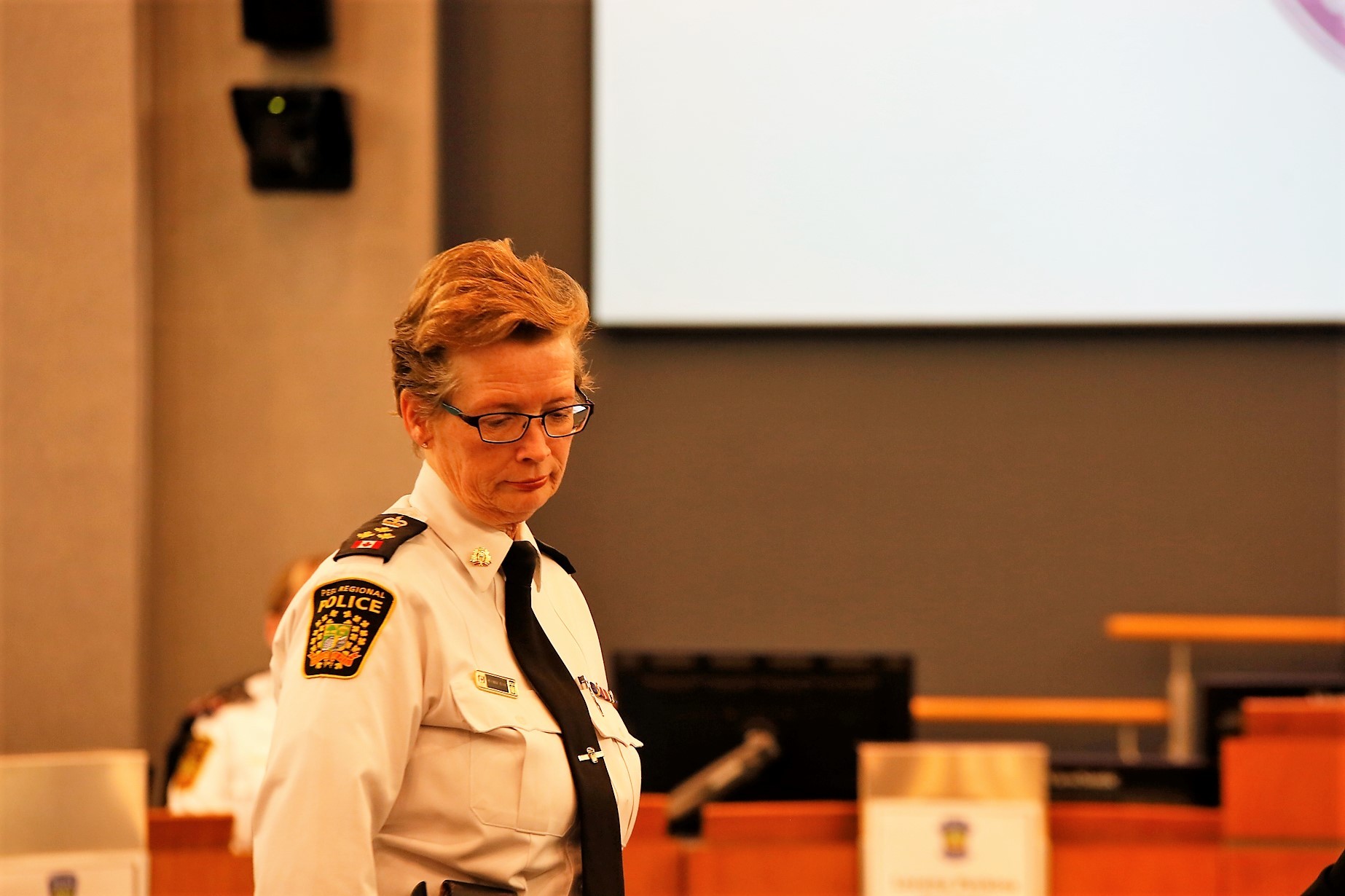
Jennifer Evans resigned as chief in January
When the police services board advised the PRP to end carding in 2015, Evans refused to comply. The force ended the practice only in 2017, after the Ontario government curtailed it. But last year, before her resignation, Evans complained, without evidence, that not being able to card had led to a spike in violence in Peel. She was widely criticized by community groups and criminal justice experts for making the unsubstantiated assertion, before announcing her resignation last fall.
Her unwillingness to acknowledge the practice’s harmful effects, despite a mounting backlash, was highlighted in 2016 when she gave an interview on CBC explaining that people were being carded “because they weren't in the area where they lived.”
"What's wrong with being in an area where you don't live?" asked host Matt Galloway, puzzled by a comment that seemed to confirm her lack of awareness of her own biases.
Interviews and surveys with police leaders and board members carried out in 2017-18 demonstrated a gap in terms of understanding that “inclusive” leadership includes “an internal, self-reflective behaviour that is dynamic over time,” the CCDI report says.

Anonymous comments by Peel police officers who participated in the audit's focus groups.
“The most substantial gap we identified is with respect to cognizance of bias. Although many commented about the need to be open to different perspectives, in all the interviews no one commented about the need to be aware of individual bias or blind spots, nor organizational blind spots.”
McCord noted the report highlights initiatives Peel Regional Police have already implemented to improve diversity and inclusion, including improved hiring practices by recruiters. The CCDI report agrees that programs and policies in place at the PRP meet progressive standards, but notes that without better self-awareness or willingness to implement them effectively, little will change.
“The overall success of these initiatives is determined by the mindset, awareness, and competence of those implementing them, and there may be a gap between the goals of the initiatives and the cultural competences and awareness of the leaders,“ the report says. “PRP Leaders and PPSB Board Members do not appear to have a common understanding of systemic oppressions such as racism, sexism, homophobia in the organization.”
For years, advocates have been pointing out the issues and demanding police address the dynamics brought to light in the report, but without results.
“What we didn’t have before is this report; this report gives us a roadmap to move forward,” McCord said.
The CCDI makes a long list of recommendations. First and foremost, a commitment to building trust, something critics said the former chief refused to do; but also enhanced accountability mechanisms, improved community engagement, better representation of women and and racialized service members, and a commitment to culture change.
The recommendations come at a time when the search is on for a replacement for former chief Evans, who left in January. The report’s harsh words for police leadership strongly suggest an outside hire may be the best option for changing a culture in desperate need of an overhaul.
McCord declined to comment on the matter.
“I can’t speak to what the plan would be for the police services board to hire or consider candidates from outside. What I can say to you is the talent within this organization, there is talent within this organization that can be chief.”
Asked if he was considering putting his name forward for the role, McCord replied, “When the posting goes out, I will have to make a decision at that time.”
Chair Iannicca, who has previously talked about the importance of choosing the right person for the role, also declined to comment on the eventual hire.
KEY RECOMMENDATIONS IN THE CCDI REPORT:
1. Acknowledge systemic issues and feedback from minority members of the police service and the community, and commit to building trust by addressing these issues and educating members of the police service.
2. Improve and enhance accountability:
-
Establish a zero-tolerance policy for sexist, racist, anti-immigrant, and homophobic remarks or jokes.
-
Establish cultural competence as a requirement for promotion.
-
Improve the rigour of diversity, equity, and inclusion competency reviews in performance appraisals.
-
Increase repercussions for inappropriate behaviour or speaking disparagingly about the populations served by the PRP.
3. Measure progress:
-
Enhance and increase diversity and inclusion related measures throughout the service.
-
Carry out diversity census and inclusion surveys every 2 years.
-
Boost opportunities to gather feedback and report back to employees on what was heard and will be done.
-
Encourage more meetings and communications and input mechanisms between service members of different ranks.
-
Conduct an audit of records of street checks and traffic stops to determine if certain groups are being stopped disproportionately.
-
Continue the Chief’s email box so that members of the PRP can communicate directly with the chief.
-
Improve public and internal surveys to understand responses according to demographics.
4. Improve awareness and understanding of diversity, equity and inclusion, and boost cultural competence:
-
Training for all employees in bias-awareness, bias mitigation, and cultural competence training, and require it at intervals for all service members. Make anti-racism training mandatory.
-
Expand educational opportunities for all officers on various populations and issues such as racialized people; cultural and religious groups; LGBTQ2+ identified individuals; and Indigenous peoples.
-
Increase diversity training for new recruits beyond the current half day, out of a 9-12 week training program.
-
Conduct an audit of those who have not completed currently available training to ensure they get it.
-
Provide mental health first-aid training for all service members at regular intervals.
-
Address concerns of “reverse discrimination” by enhancing communication and education on the experiences of minority members of the service; educate PRP members on privilege, stereotypes and bias, particularly pertaining to gender and racialized persons.
5. Enhance community engagement:
-
Increase resources for community policing and boost its prestige by making it a criterion for promotion.
-
Consider expanding community advisory groups to new demographics.
6. Improve representation of under-represented groups, particularly women and racialized service members:
-
Educate leaders in understanding the impact their biases may have on selection, development, and advancement decisions.
-
Offer development programs to women and racialized persons to encourage them to consider opportunities for development and different positions.
-
Expand the initiative of hosting recruitment fairs with under-represented communities.
7. Enhance accessibility and commit to inclusion of people with disabilities:
-
Increase technology support and flexible work arrangements.
-
Communicate accommodation policies regularly.
-
Apply policies and practices related to disability equitably across the organization.
8. Commit to organizational culture change:
-
Create a task force or working group involving members of the Chief’s management group and others throughout different ranks and divisions to identify the culture PRP wants to create, what aspects of the organizational culture need to change and/or can reasonably be changed, and use a rigorous change management approach to embark on an organizational culture change initiative.
OTHER KEY FINDINGS OF THE CCDI REPORT:
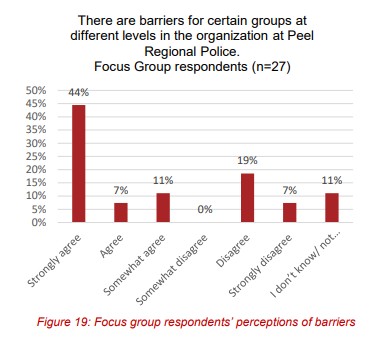
- “We observed a tendency by some in the leadership team and members of the police service to minimize, misunderstand, or disregard the experiences of minorities in the organization, and/or to disregard the feedback from some populations because it was not reflective of the majority view, coupled with a resignation that ‘you can’t please everyone’. The fact that the majority are not experiencing the problem doesn’t negate the existence of the problem.”
- “A significant majority (87%) of Culture Meter Focus Group respondents stated that it is common to hear and witness homophobic, sexist, and anti-immigrant language at PRP. … 23% of respondents indicating it was happening at least weekly. A further 39% of respondents said it was happening monthly or a few times a year.”
- “In some cases, Culture Meter Focus Group respondents report that employees have been forced to leave the Peel Regional Police after reporting harassment or discrimination because of the negative consequences or reprisals for doing so.”
- ”Some respondents mentioned that as a consequence of the inability to speak up, it is causing a poor work environment, high stress and anxiety, and effects on mental health and wellbeing.”
- “Focus group participants indicated that when discrimination or harassment occurs, the tendency is to work through it one-on-one. “The option to report it is generally not considered for fear of reprisals.” Individuals indicated that those who report will be “marked” and harassed even further either by peers or supervisors, managers, etc. Respondents cited that racist, sexist, bullying, and homophobic language is used toward peers. Some respondents stated that when this takes place, they don’t feel that they can report, as in many cases the ‘culprit’ is someone in a more senior position.
Anonymous quotes by Peel police officers who took part in the focus groups for the audit:
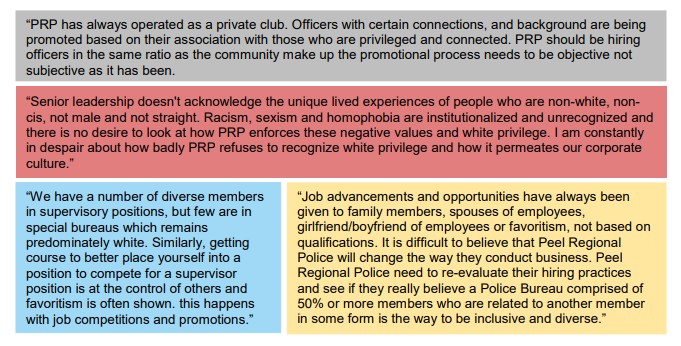
- “The organization say they support diversity, but they do not...They talk badly about people who live in Brampton. Many of the newcomers in the service live locally ... Many of the top leaders live out of the region.”
- “I have heard officers say Brampton is a shit hole.”
- “Sad to hear them talk badly about Brampton every day ... . I note they see Mississauga in a different light, and I suspect that is because Brampton looks like it is filled with more newcomers. Same crime can happen in Mississauga, but it is viewed differently”.
- “I have heard many leaders say they would never live in Brampton.”
Submit a correction about this story


